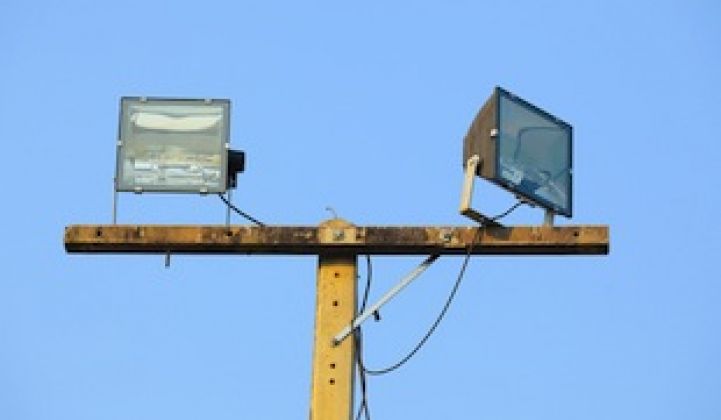A coalition of ten states and the City of New York just announced that the Department of Energy has committed to push forward four delayed energy efficiency standards that could save utility customers more than $3.8 billion annually once in full effect -- and save enough electricity to power almost 4 million homes.
Clearing the roadblocks for these long-overdue energy savings standards will help the environment, the economy, and our wallets -- all the while supporting President Obama’s climate plan to reduce carbon dioxide pollution.
DOE sent a letter to the State of New York and others yesterday committing to issue Notices of Proposed Rulemaking this month for energy conservation standards for metal halide lamps, commercial refrigeration equipment, and walk-in coolers and freezers, and for electric motors in November.
The standards, which are currently seven to eighteen months overdue, in violation of the Energy Policy and Conservation Act, would become final next year.
Standards are a “win-win”
The Natural Resources Defense Council has been among those continuing to push the DOE to implement energy-saving standards, which are a “win-win” because they save consumers billions of dollars and help avoid the need for new power plants to be built. The pollution savings from existing efficiency standards alone will avoid 9 billion tons of carbon dioxide emissions cumulatively by 2045, equal to the amount produced annually by 1.8 billion automobiles -- more than the number of cars on the roads worldwide -- while saving consumers and businesses a net $1.1 trillion.
Yet, despite these benefits and Congress’ explicit deadlines for setting standards, President Obama’s endorsement of those deadlines in a 2009 memorandum, and the nation’s urgent need to reduce energy’s environmental impacts and costs to consumers, the DOE had once again fallen behind on its legally mandated deadlines.
As a result, a coalition comprising the state of New York; the attorneys general for Connecticut, Maine, Maryland, Massachusetts, Oregon, Rhode Island, Vermont, and Washington; the California Energy Commission; the corporation counsel for the City of New York; the National Consumer Law Center; and the NRDC has been pushing the DOE to act on energy-saving standards for:
- Metal halide lamps, which are used to light outdoor parking areas and roadways, and are also used in high-ceiling lighting in commercial, industrial and public places, such as warehouses and gymnasiums
- Walk-in coolers and freezers, which, as their name implies, are refrigerators and freezers large enough to walk into that are used for bulk food storage and often found in restaurants and grocery stores
- Commercial refrigeration equipment, such as the refrigerated and frozen food display cases in your local market and convenience stores
- Electric motors ranging from 1 to 500 horsepower in size that can be used in any device or equipment that converts electricity into movement, such as a pump or fan.
Delays are costly
Without updated standards, these products continue to waste power, leading to higher utility bills for all while harming the environment. In fact, the delays from just these four products found in nearly every U.S. community already have cost Americans an estimated $2.31 billion in missed savings. Each additional month costs about $156 million.
The damage isn’t just to our pocketbooks. These delays have caused at least 27.7 million metric tons of unnecessary carbon dioxide emissions; each additional month adds another 2.2 million metric tons. That pollutes the air and water, threatening public health and increasing the risk of extreme weather events.
The American Council for an Energy-Efficient Economy (ACEEE) estimates that standards for the four products covered under the commitment announced today could cumulatively save about 5.8 quads of electricity through 2035, enough to supply all of the energy needs in the United States for three weeks, and slash 27 million metric tons of climate-warming carbon pollution annually, equivalent to taking at least six coal-fired power plants offline.
And there’s far more potential out there. The Appliance Standards Awareness Project estimates that 700 million metric tons of savings could be achieved cumulatively by 2030 through standards set over the next three years, including the four in today’s announcement.
It’s heartening that President Obama recently renewed his commitment to efficiency standards as part of his climate action plan, and key members of his administration have echoed their importance. New Secretary of Energy Ernie Moniz has also pledged to get the standards program back on track.
The commitment announced today reaffirms those promises and represents an extremely positive sign of support for energy efficiency as our cleanest, cheapest “resource” as doing as much work, or less, with the same amount of energy, while avoiding the need to build expensive new power plants.
Much of the holdup on efficiency standards has been at the White House Office of Information and Regulatory Affairs (OIRA), which reviews executive branch agency regulatory standards before they become final. OIRA will need to review these rules and others in the pipeline in a timely fashion to make sure they don’t get stuck in bureaucratic red tape.
DOE’s efficiency standards program has huge benefits for consumers, for electricity reliability, and for curbing global warming. We will continue to watch the DOE closely, however, to make sure that all the standards covered by the climate action plan are issued on time and will take appropriate legal action if delays persist.
***
Meg Waltner is an Energy Efficiency Advocate at the Natural Resources Defense Council. This piece was originally published at NRDC's Switchboard blog and was reprinted with permission.



